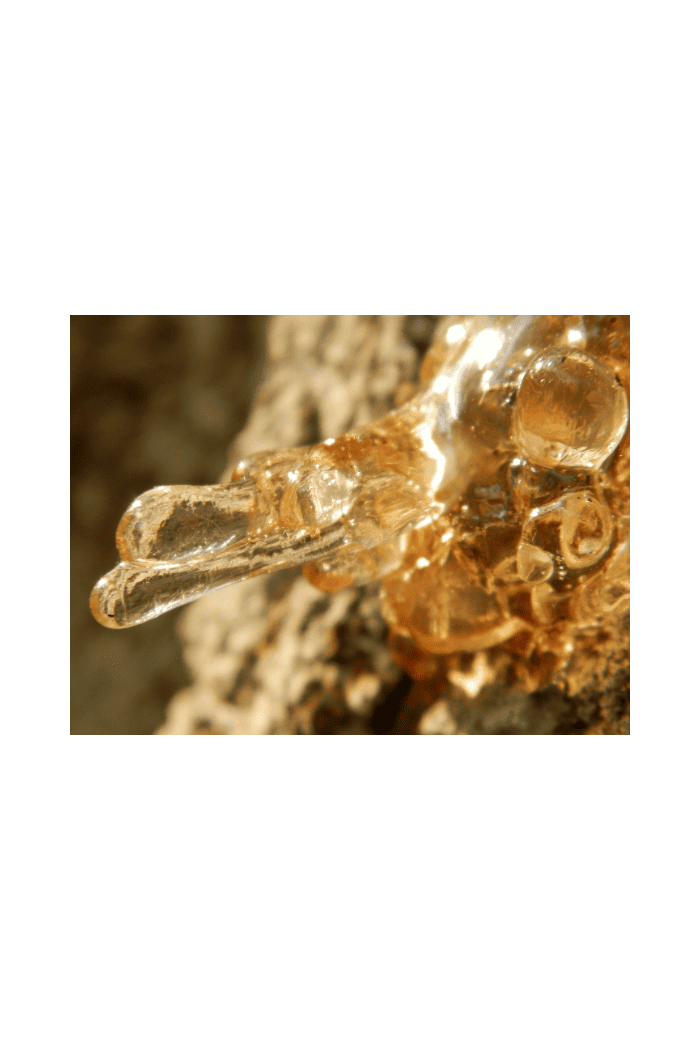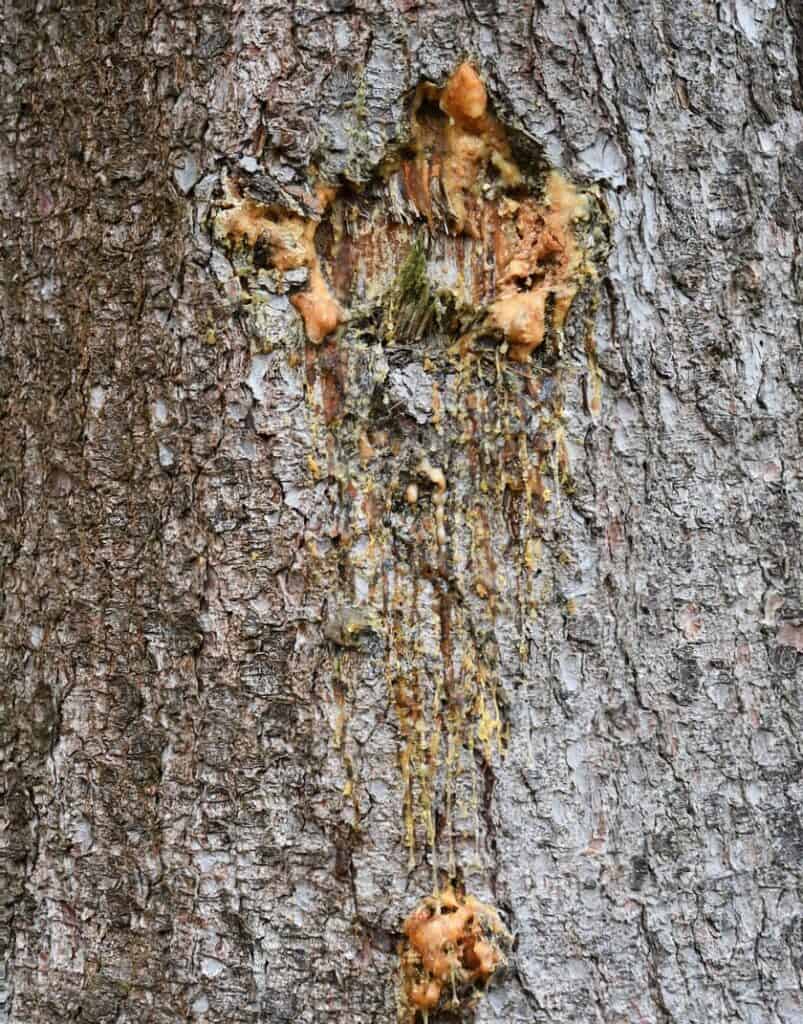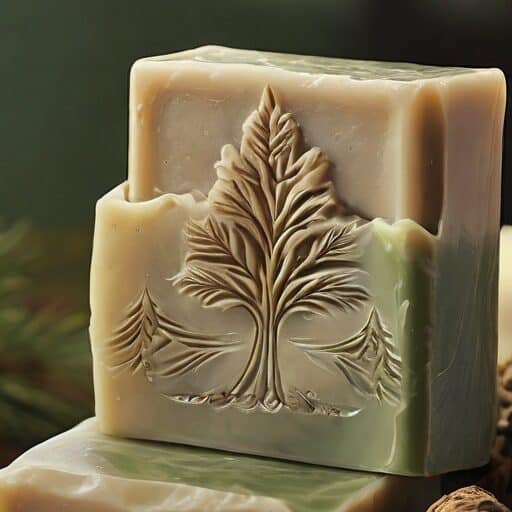
In researching the uses of Ponderosa pine trees, I came to pine sap or pitch and realized it’s a subject of its own. Turns out there’s much more to pine sap than what most people might realize.
What exactly can pine pitch be used for? Pine Pitch is good for glue, salve, incense, solvent, varnish, waterproofing, crafting, jewelry making, and medicine, just to mention a few things.
What Exactly is Pine Pitch or Sap?
Pine pitch, also known as resin or sap, is a sticky substance that oozes from the bark of pine trees. It serves as a protective mechanism for the tree, sealing wounds and preventing the entry of pathogens. It is a complex mixture of terpenes, waxes, and other organic compounds. These components contribute to its adhesive nature and protective qualities.
Sap, Pitch, and Resin Explained
Let’s find out what the difference is between pine sap, pitch, and resin.
- Sap is from a runny to a thick honey-like substance that flows easily, especially in the heat. You can typically find sap from freshly cut trees.
- Pitch is darker and can appear as a crystalized form of sap, and is what the tree produces to protect itself from wounds and damage.
- Resin is the dried and harder version of the pitch. This is the element that is thicker and tackier than pitch. A tree will use resin, to further protect itself when wounded with what can appear as having a glass-like makeup.
Now, let’s talk about some of the uses of this forest-made product.

Uses For Pine Pitch, Sap, or Resin
Below is a list and description of some commonly known uses of pine pitch, sap, and resin.
1. Pine Pitch as a Glue -whether you make your own or buy pitch or sap glue, you’ll find many uses for this sticky substance that can turn as hard as glass. The stickiness can be controlled by adding hardwood charcoal and strengthened by adding plant fiber, animal hair, or other ground-up fiber material. To keep the glue softer and pliable, animal fat or beeswax can be mixed in with the glue mixture. Use the glue to join wood projects together, fire starters, or reinforce and waterproofing or sealer on things like baskets.
2. Pine Resin Salve -This salve is used for various things, such as antiseptic for scratches, minor wounds, and rashes. It also helps with respiratory congestion and chest rub. Due to the warming sensation the salve can be used for soothing achy joints and sore muscles.
Certain pines offer anti-inflammatory properties as well. Today, Pine Resin Salve can be purchased commercially, or you can still make your own if you have the available ingredients. You’ll need pine resin that you melt in a double boiler.
DO NOT heat pine resin directly over a fire due to it being so flammable. Strain it and then add two parts oil and beeswax and mix together. There are several recipes available online by searching “how to make pine resin salve.”
Or, if you prefer, you can purchase a Pine Salve Ointment here on Amazon.
3. Pine Pitch Gum, or pine resin gum, is a substance derived from the fluid of pine, spruce, and fir trees. It has been used for centuries for its various medicinal and practical purposes. It’s my understanding that pitch is no longer used in today’s gum. Some Native American tribes utilized pine pitch as a gum for the treatment of rheumatism. In my opinion, it does not sound particularly appetizing, and I’ve not seen any offerings in any stores in the gum section.
4. Medicinal Purposes – Pine pitch, with its antimicrobial properties, is great for its ability to heal wounds. It can help to protect scraps, burns, and cuts. In addition, it’s possible that it has anti-inflammatory effects and can provide pain relief.
5. Pine Pitch for Boots and Leather – Mixing pine pitch with certain waxes or oils helps to weatherproof and preserve leather and boots.

6. Pine Pitch, Sap, Resin Incense – The resin extracted from trees like Pinus colophoniae is employed to create pine incense.
7. Rosin – A byproduct of resin after being distilled for its turpentine. Rosin is not the same as resin and has various uses today in different industries. To learn more, visit the Rosin Factory and read more about its uses.
8. Pine pitch potatoes – No longer practiced, commercially anyway. In extracting turpentine through distillation, a byproduct called rosin is formed. Back in the day, in turpentine camps, this rosin would be heated, and potatoes would get thrown in and cooked in the molten rosin. The claim is that the rosin would force the potato to cook in its water, which would lock in the potato flavor. To learn more about this, click this link and read this long multiple article. the-elusive-roots-of-rosin-potatoes
9. Pine pitch resin or tar soap is made by infusing oils like palm or olive oil with pine pitch, resin, or tar. Then, the oil is blended with coconut oil, tallow, and sweet almond oil. Pine pitch oil is derived through a distilling process of pitch-soaked wood (fatwood) and the use of extraction solvents such as a lye solution with other additives.
Are you interested in making your own pine tar soap? If so, here’s a good recipe source.

10. Pine pitch turpentine production is a process involving the extraction of resin from pine trees, a natural substance that seeps from the tree when it is wounded or tapped. This resin is then collected and distilled to separate the volatile turpentine oil from the solid rosin.
11. Natural Insect Repellent: Thanks to its natural fungicide and insect-repellent properties, pine tar can be used to ward off bugs and insects, which is particularly useful in camping or hiking scenarios.
12. Pine pitch varnish is a natural finish made from pine resin derived from pine trees, which I’ve talked about previously in this article. It’s created by heating and purifying the resin, then mixing it with a solvent like turpentine. This varnish dries hard and smooth, offering a protective, waterproof coating. Historically, it’s been used for preserving wood, especially in bows, arrows, maritime, and some furniture-making applications.
13. Pine pitch wine, known as Retsina, is a traditional Greek wine with a history dating back over 4000 years. It is made by adding natural resin extracted from Aleppo Pine to white or rosé wines during fermentation. This unique process, originally used to seal wine containers and preserve the wine, imparts a distinctive pine flavor to the wine, making Retsina a unique, historically rich, and robust drink. Source: Retsina History
Is it Hard to Collect Pine Pitch or Sap?
It’s not hard or difficult at all! Maybe you are interested in trying your hand at something new and a bit rustic; collecting pine sap can be an enriching experience. The key is to approach it with a bit of know-how and a lot of respect for our evergreen benefactors.
Keep in mind, though, it might take some patience. It’s not like there’s pine sap, pitch, or resin flowing from every tree in the forest.
The best practice for collecting your own gooey gold is to find trees that already have sap flowing from a current or previous wound on the tree.
We have many trees on our property that are being attacked by a bark beetle, and as a defense mechanism, the tree excretes sap to protect itself. This is a great way to find and collect natural flowing sap or resin.
Final Thought
The uses of pine pitch are as diverse as its history. From traditional remedies to cutting-edge industrial applications, this natural resin continues to prove its worth in the modern world.
Whether you’re interested in crafting, medicine, or simply exploring nature’s offerings, pine pitch stands out as a versatile and valuable resource.
If you found this to be an interesting read, please check out this article, “What is Pine Wood Good for? (15 Not-so-Obvious Uses).”
